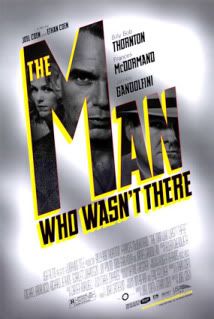I don't mean the title of this post to insinuate anything remotely negative about the film. It relates to my specific lack of attention during screening, and the fact that it snuck in relatively low-key when released (as I generally know when the Coen's release a movie, and I'd heard little about this film). This is also the first film that I watched with another person (in the context of this blog, not, y'know...ever); normally I watch these by myself, and I thought it would enhance the experience to have company. This also meant that there was someone to have conversations with about the movie, sometimes instead of what the experts call "paying attention."
If you haven't heard of the Coen Brothers, what the heck, man? The Coen's are great. My favorite is The Big Lebowski, what's yours? In 2001, they released an immensely faithful neo-noir that completely slipped under my radar. Billy Bob Thornton plays the title character, and the film features Coen regular Frances McDormand as his wife. Michael Badalucco, James Gandolfini, Scarlett Johansson, Tony Shalhoub, Richard Jenkins, and John Polito also star, and if they had used unknown actors instead, it would have been next-to-impossible to tell that this film wasn't made in the 1950s.
The Man Who Wasn't There is a complex, involved story of dissatisfied and reserved barber Ed Crane (Thornton) living in 1949 Santa Rosa, California. His wife Doris (McDormand) is a distant alcoholic, originally drawn to his tacit nature, but is now seeking comfort in the arms of her boss, Big Dave Brewster (Gandolfini). When a weird little man in a toupée comes to the barber shop talking about the miracle new process called "Dry Cleaning," Crane (inexplicably) wants to get in on that sweet, sweet action. He blackmails Big Dave anonymously for the $10,000 he needs to invest in the fabulous new world of dry cleaning. In the fine tradition of film noir, does not work out as planned in any way whatsoever. Toupée guy also asked Big Dave for the $10,000, so Big Dave gets suspicious of the blackmail amount, beats a confession out of Toupée guy, and tries to kill Ed. Ed retaliates and kills Big Dave himself, which leads to his wife being implicated in the murder, a few twists and turns along the way, as well as Scarlett Johansson as a teenage piano playing nymphet that tries to give Ed a road hummer. Additionally, in the tradition of films from the 1950s, the bad guy receives his final comeuppance at the conclusion of the film.
As a fan of classic film noir (like Double Indemnity, Sunset Boulevard, and Mildred Pierce), I appreciate how painstakingly Coens recreated the look and feel of the 1950s, and specifically 1950s cinema. Crane is always smoking an unfiltered Chesterfield, and he expresses himself most frequently through a haze of smoke and narration. He speaks infrequently, but we hear his voice almost constantly. It's almost as though he's thinking to himself as the movie goes along, and less of a retrospective narration.
The sets are all carefully populated with contemporaneous furniture and decorations, costumes, and even the locations look like they're from the 50s, and haven't been touched by a culture that's even heard of bellbottoms, tie-die, Flock of Seagulls, grunge music, or iPods. As I said before, if this film didn't have such well-known actors as Billy Bob Thornton etc., it would be next to impossible to recognize this as a modern movie. As you can see from the above photo, they also converted the film to black and white (although they didn't film directly to b&w). They use stable angles, eye-level placement, not much movement of the camera at all, and a few signature Coen touches (like the slow-motion car flying from left to right after Crane runs off the road, presenting a dash of surreal humour to a dramatic situation).
Unfortunately, being such a by-the-books faithful neo-noir means that it's relatively easy to predict the general scope of the film. A lot of stuff is happening, a lot of characters coming in and out, intersecting, like ships passing in the night, but the ultimate ending was pretty much determined from the beginning. If you've ever seen a James Cagney film, you know that the sensibilities of that era demanded that a character that caused harm to others or committed crimes needed to eventually meet the hands of the justice system, and not be allowed to continue without consequences (even if the "bad guy" is the main character, and ostensibly the hero of the story).
It just occurs to me, that I've been calling the film a "neo-noir," and that may not be entirely accurate. Generally, neo-noir assumes that the sensibilities of the noir genre are used, with enhancements and expansion using modern themes and other attributes that weren't used when noir was contemporary. That's not exactly the case in this particular film (a good example of neo-noir is Brick, which I'll have to write about one of these days). The Coen brothers have basically recreated the noir genre, with common themes, elements, and camerawork that would have been in use in the 40s and 50s. I don't know exactly what you'd call that... retro-noir? It's really good, is my point.
If you like Joel and/or Ethan Coen, film noir, or even neo-noir, The Man Who Wasn't There is recommended. If you haven't, I still recommend it, and maybe you'll want to go out and see more Coen brothers movies. Couldn't hurt, right? Four and a half out of five unfiltered Chesterfields, or four and a half drunken '50s wives out of five.




No comments:
Post a Comment